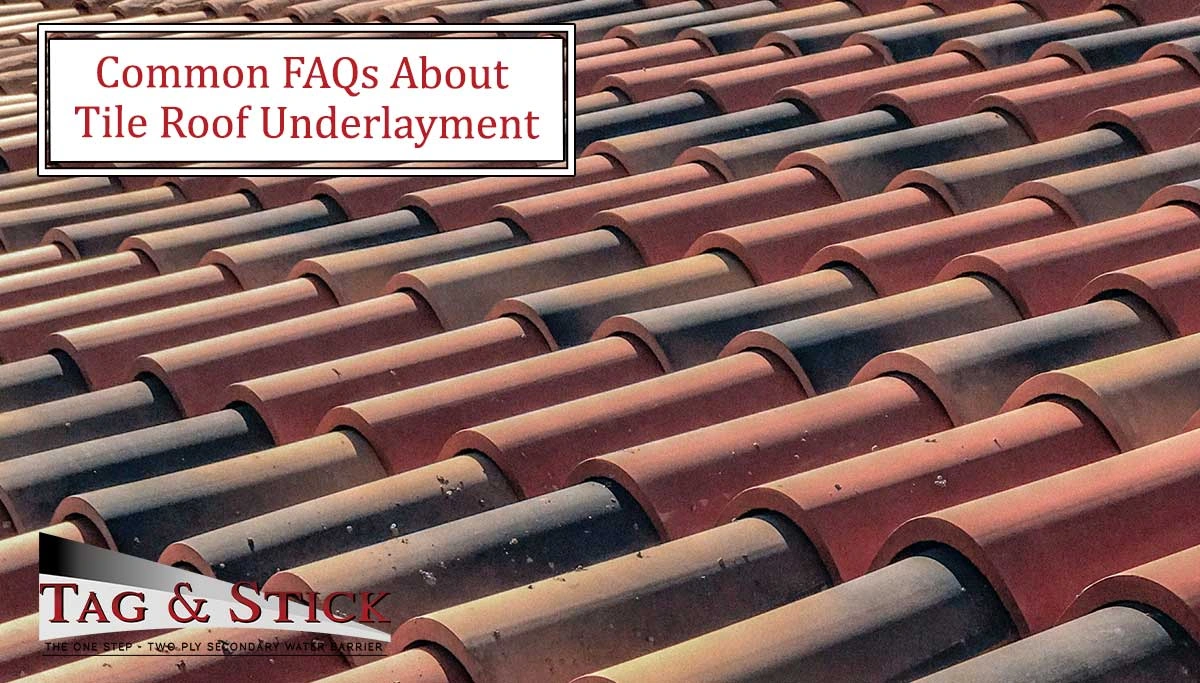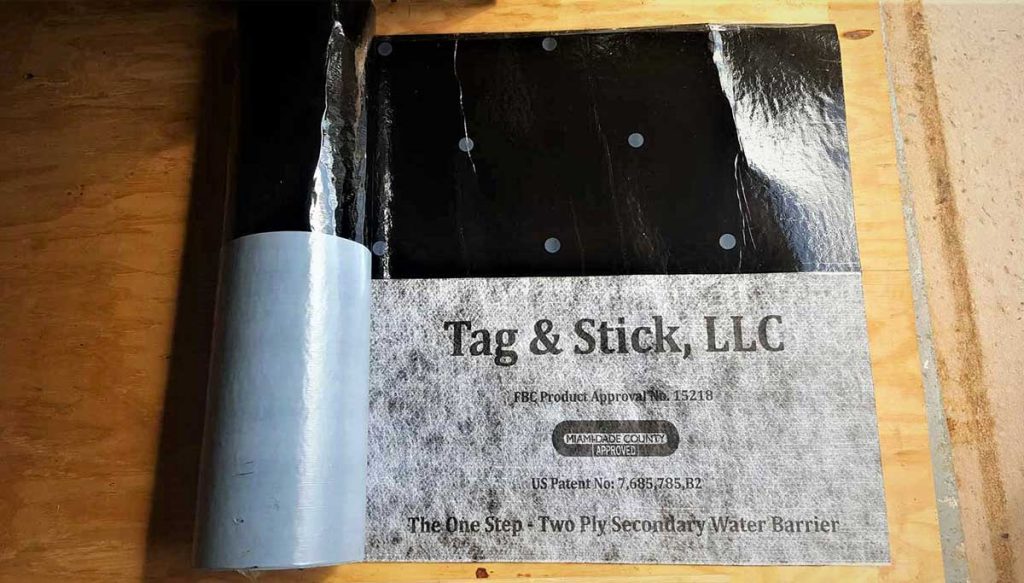Common FAQs About Tile Roof Underlayment

- What Is Tile Roof Underlayment?
- Why Is Underlayment Important For Tile Roofs?
- What Types of Underlayment Are Used For Tile Roofs?
- How Is Tile Roof Underlayment Installed?
- How Long Does Tile Roof Underlayment Last?
- What Are Some Signs That My Tile Roof Underlayment Needs To Be Replaced?
- Who Should Install My Tile Roof Underlayment?
- Tag & Stick – Mechanically Attached Self-Adhering Underlayment For Your Roof
South Florida homeowners love their tile roofs. From stately black slate roofs to the beautiful terracotta hue of a Tuscan-styled villa, tiles can add a feeling of beauty to our homes. However, in terms of performance, the real star of the show lies beneath the tiled exterior – in the underlayment. This critical component of your roof acts as a protective barrier and prevents water damage and ensuring the longevity of your roof. In this guide, we will address some of the most frequently asked questions regarding tile roof underlayment that will help you make informed decisions about your upcoming roofing project.
What Is Tile Roof Underlayment?

Tile roof underlayment is a layer of protective material installed over the roof deck and underneath the tiles. Its primary function is to create a waterproof barrier that prevents water from penetrating the roof structure, even if the tiles are damaged or displaced. You can think of it as the last line of defense against leaks, protecting your home from the elements.
Why Is Underlayment Important For Tile Roofs?

Tile roofs, while durable, are not completely waterproof on their own. Wind-driven rain, snow, and ice can penetrate between the tiles. Underlayment provides a continuous barrier, preventing this water from reaching the sheathing and causing structural damage, mold growth, and other costly problems. In South Florida, tile roof underlayment is heavily regulated and therefore needs to adhere to strict wind uplift regulations from the Florida Building Code.
What Types of Underlayment Are Used For Tile Roofs?

There are several types of underlayment that are suitable for tile roofs and each one has its advantages and disadvantages.
Hot Mopped Underlayment
This is a traditional and cost-effective option, typically made from asphalt-saturated felt. It offers good water resistance but is less durable than other options and can be susceptible to tearing or cracking, especially in extreme temperatures. Two layers are required for tile roofs.
Synthetic Underlayment
Synthetic underlayments are significantly stronger and more durable than felt and are made from woven or spun synthetic materials.
They are superior to felt underlayments in:
- Tear resistance
- Water resistance
- UV protection
They are also lighter, safer, and easier to install than felt, making them a popular choice for tile roofs.
Self-Adhering Underlayment
Tag & Stick’s flagship 2-ply Modified underlayment is a great example of self-adhering underlayment. It provides an extremely strong and waterproof barrier, primarily for tiled roofs (although it is suitable for all roof types) and in vulnerable areas like valleys and around chimneys. Self-adhering underlayment’s superior protection makes it a worthwhile investment for high-performance roofs.
How Is Tile Roof Underlayment Installed?
The installation process varies depending on the type of underlayment used, but most roofing projects will generally involve the following steps:
Roof Deck Preparation
The roof deck should be clean, smooth, and free of any debris or protrusions. A clean work surface provides the best opportunity for proper adhesion.
Underlayment Installation
The underlayment is rolled out and secured to the roof deck using ring-shanked nails, with overlapping seams to ensure a continuous barrier. Self-adhering underlayment is applied by peeling off the backing and pressing it onto the deck. Tag & Stick’s 2-ply Modified solution has the added advantage of being mechanically attached as well for an extra level of durability.
Flashing Installation
After the underlayment has been put in place, flashing is installed around chimneys, vents, and other roof penetrations to create a watertight seal. These areas are important as the angles can create areas for water to pool and soak into the roof surface if they are not adequately protected.
Counter-flashing
Counter-flashing is a final step that is installed over the flashing to further protect these vulnerable areas. Every joint is a potential weakness and therefore they need to be properly sealed.
How Long Does Tile Roof Underlayment Last?
The lifespan of tile roof underlayment depends on several factors, including the type of underlayment, the climate, and the quality of the installation. As a rule of thumb, roof underlayment should last over 20 years if well cared for and maintained.
What Are Some Signs That My Tile Roof Underlayment Needs To Be Replaced?
The helpful points below, while not exhaustive, will help you discern whether or not it’s time to consider replacing your underlayment.
Leaks
In a very humid and high rainfall climate such as South Florida, there is an increased chance of water leaks forming if the roof underlayment has begun to deteriorate to such a point that it is no longer waterproof. You will notice these leaks inside your home.
Damaged Tiles
Damaged tiles can be a point of ingress of water and may accompany leaks. If the broken tiles are localized, then the chance is slim that there could be issues with the underlayment. However, if the damage is more widespread then you need to consider re-roofing, which will include the replacement of your underlayment.
Curling or Buckling
Without climbing onto the roof yourself, see if you can take a look at the eaves or around the edges of the roof from the ground. If there appears to be curling or buckling of the underlayment, then perhaps it’s time to call a reputable roofer to inspect the state of your underlayment.
Age
In the same way that you would consider servicing your motor car or doing an oil change every 10,000 miles, roof underlayment can be due for an inspection too. If your roof has been installed for a timeframe of anywhere from 15 – 20 years, do the right thing and call your local roofer.
Who Should Install My Tile Roof Underlayment?
Tile roof underlayment should ALWAYS be installed by a qualified and experienced roofing contractor. Proper installation is crucial to ensure the underlayment performs its intended function according to its specifications. A professional contractor also possesses the knowledge, skills, and tools necessary to install the underlayment correctly and efficiently.
Tag & Stick – Mechanically Attached Self-Adhering Underlayment For Your Roof
With over 25 years of experience in the South Florida roofing industry, we took note of the challenges that roofing contractors faced when replacing underlayment, especially the delamination of the roofing deck. As a response, we have developed one of the best options for underlayment available for any roof, tiled or otherwise.
To find out more information about our innovative underlayment, call us at 954-255-3107.